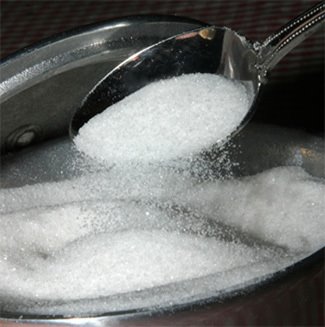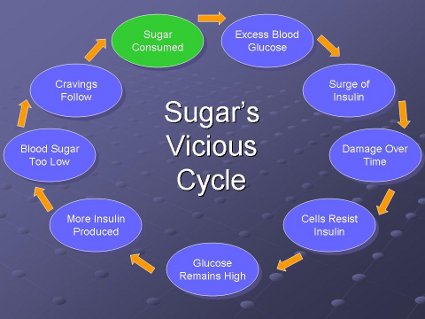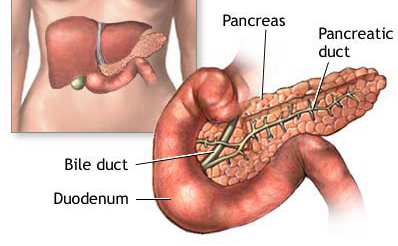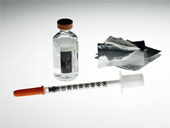| Share |  |
 | |||
Sugar Bondage - Why You Need To Be Free - Part 2
 Sugar plays an enormous role in the development of a broad spectrum of health conditions and degenerative disease. Last month we looked at how white refined sugar is chemically produced and how that process makes it nutritionally deficient. We discovered how widespread this substance is in the diet and food supply of today’s society, and how it negatively impacts our health.
Sugar plays an enormous role in the development of a broad spectrum of health conditions and degenerative disease. Last month we looked at how white refined sugar is chemically produced and how that process makes it nutritionally deficient. We discovered how widespread this substance is in the diet and food supply of today’s society, and how it negatively impacts our health.
Disease occurs in the body when the body chemistry is upset and the body loses that balanced state known as “homeostasis”. Although other factors exist that serve to disrupt this balance, such as alcohol, drugs and other toxic chemicals, caffeine, bad fats and stress that turns to “distress”, sugar “takes the cake” for throwing bodily systems out of kilter and setting the stage for degenerative disease.
What Sugar Does in Our Cells

In her book, Licking the Sugar Habit”, Dr. Nancy Appleton, a former sugarholic who has made studying the effects of sugar in the body her life work, gives a documented list based on her research called “146 Reasons Sugar is Ruining Your Health” (you can read this list here: http://www.nancyappleton.com/NA144reasons.html). She explains that breakdowns in health occur when the body is no longer able to regain balance because organs are exhausted from overwork and cellular communication is impaired from poor diet and lifestyle habits that continue over a period of time.
If you look at what happens to the cells in your body when you eat refined sugar, you will better understand why so many disease conditions and symptoms have been connected with sugar intake. Yet if you ask the average person why they should avoid sugar, the answer you get usually pertains to calories. It seems that people prefer to worry about their weight and fat – things other people see – than the far more deadly things that may be going on in their cells, tissues and organs.
There is sadly little understanding that the damage sugar inflicts in the body is slow and insidious, existing long before any symptoms become obvious or diagnosable. If only people would realize the many ways that sugar interferes with normal bodily processes before a breakdown in health takes place, they would be able to avoid those destructive repercussions.
Cellular Communication is the Key
In order for the functions of the body to occur as our Creator designed, cells must be able to effectively communicate with each other. It takes the right proteins, sugars, fats and other key nutrients in the diet for a cell membrane to be healthy and flexible enough for its receptors to receive the messages needed to run the systems of the body.
Natural sugars are an important component of healthy cell membranes, but processed sugars (along with the wrongs fats) can make cell membranes so stiff and unresponsive that these messages cannot get inside the nucleus of the cell to be interpreted. When cells are hindered in their ability to communicate, the normal operation of the body is impaired and roots of disease begin to take hold.
How the Body Responds to Sugar
When we eat refined sugar, the normal digestive processes that occur in the mouth and stomach are bypassed, because refined sugar contains no fiber and other nutrients to digest. It rapidly breaks down to glucose and is directly absorbed into the bloodstream through the small intestine. Glucose, or blood sugar, in many respects, is the fuel that runs the body. If it is out of normal balance, many types of symptoms develop, since a great many tissues and organs depend on it to function.
Insulin is a powerful hormone secreted by the pancreas to control glucose levels in the bloodstream. It keeps blood glucose levels within a normal range by triggering cell receptors to open, allowing insulin-sensitive muscle and fat tissue to absorb glucose into their cells to be used for energy. As the glucose enters the cells, the level of glucose in the blood lowers to a normal level. Any extra glucose not needed for immediate energy is stored by the body in the liver and muscle cells in the form of glycogen to be converted back to glucose if blood sugar levels should drop too low.
A Vicious Cycle
Every surge of sugar creates excess glucose in the bloodstream. This excess glucose, in turn, requires a surge of insulin to bring the levels to a normal range. It is no wonder that repeated ingestions of refined sugar stresses these receptors to the point where they malfunction and become more and more resistant to insulin. This “insulin resistance” results in normal levels of insulin not being enough to trigger the signal for glucose absorption. When the needed glucose can’t enter the cells, the glucose level in the blood remains too high and the hypothalamus alerts the pituitary gland to send a message to the pancreas to pump out more insulin to correct the situation.

This excess production of insulin can then cause blood sugar levels to drop too quickly, which stresses the adrenal glands. They respond by sending adrenaline to stimulate the pancreas to release glucagon which, in turn, causes the liver to convert some of its glycogen back into glucose to prevent the effects of low blood sugar from occurring in the body. If blood sugar becomes too low, a person will experience symptoms of hypoglycemia, such as weakness, intense hunger, heart palpitations, trembling, anxiety, confusion and drowsiness.
The adrenal glands, as well as the pancreas, get very overworked when sugar is eaten on a regular basis. They can eventually suffer fatigue and damage from being overstressed too often. Because their functions can become quite sluggish, there may be delays in the messages reaching the pancreas. Meanwhile, the pancreas continues to secrete excess amounts of insulin, which lowers the blood sugar too much. During this period of delay, while the conversion of glycogen to glucose is taking place, there will often be strong cravings for more sugar and refined carbohydrates. If these cravings are given into and more sugar and refined carbohydrates are consumed, the whole vicious cycle repeats itself.
The Plight of the Pancreas 
As the cycle progresses, insulin becomes a toxic agent to the cell membrane and the more the cell is exposed to insulin, the more resistant it becomes in an effort to protect itself from insulin’s toxic effects. This can result in high levels of both glucose and insulin circulating in the blood at the same time. This condition, in turn, sets the stage for the development of diabetes, which occurs when the pancreas finally wears out and can no longer keep up with the increased demand for insulin.
There is good reason for the pancreas being so vulnerable to this abuse that leads to exhaustion that many do not realize or consider. The pancreas pulls double duty in the body, because it is an organ of both the digestive and the endocrine systems. In addition to secreting insulin to regulate blood sugar, it is also responsible for secreting enzymes needed to finish the last phase of digestion in the small intestine. When people overeat and/or the digestive process is hindered (by the consumption of enzyme deficient foods due to cooking or irradiation, lack of minerals, the consumption of antacids or other factors - see December, 2008 article on “Digestion – It All Starts Here”), the pancreas has to neglect its job of producing insulin to make extra enzymes for these foods that have not been properly digested in the stomach in an effort to keep undigested food from entering the bloodstream.
The consumption of refined sugar just adds insult to injury, because its super-quick absorption demands that huge amounts of insulin be produced and secreted in an attempt to lower the amount of glucose in the blood. With the double abuse it suffers, it is no wonder the pancreas becomes overworked and sends out erratic or insufficient amounts of insulin.
The Results of Insulin Resistance
Type II, or Adult Onset Diabetes, as it is frequently referred to, is by far the most prevalent modern disease brought on by insulin resistance. It is actually the fastest growing disease in the United States; over a third of the population is pre-diabetic, which means that the disease is present and developing in the body, though symptoms have not yet appeared.  It can take years of high levels of glucose spiking insulin in the body to produce inflammation and damage to cell membranes to the point where they lose their ability to respond to insulin. As this process occurs and refined sugar and carbohydrates continue to be consumed, the stage is set for the wearing down of the pancreas. When it is no longer able to produce insulin in sufficient amounts and blood sugar levels become out of control, the person now has diabetes that often requires medical intervention to control (though this intervention neither addresses the root cause nor stops the progression of the disease).
It can take years of high levels of glucose spiking insulin in the body to produce inflammation and damage to cell membranes to the point where they lose their ability to respond to insulin. As this process occurs and refined sugar and carbohydrates continue to be consumed, the stage is set for the wearing down of the pancreas. When it is no longer able to produce insulin in sufficient amounts and blood sugar levels become out of control, the person now has diabetes that often requires medical intervention to control (though this intervention neither addresses the root cause nor stops the progression of the disease).
Though hypoglycemia and diabetes are the most prevalent conditions developed from high levels of blood sugar and insulin fluctuations, they are by no means the only impairments to health that occur from the effects of too little or too much glucose or insulin in the bloodstream. Though by no means an exhaustive list, here are some brief highlights of other conditions in the body that can occur as a result of consuming highly refined dietary carbohydrates for a period of years:
- Storage of fat in inactive parts of the body, such as the abdomen, buttocks, breasts and thighs when glycogen storage areas in the liver from excess glucose production are full
- Storage of fat around organs and blood vessels when storage sites in the liver are full, causing the reduction of oxygen and potential for disease
- Liver enlargement (“fatty” liver)
- Decrease in the production of glucagon, a hormone involved in the burning of previously stored fat
- Increase in triglyceride levels as excess sugar is stored as fat
- Thickening of arterial walls, stiffening blood vessels and increasing risk of vascular disease
- Increased cholesterol levels – higher insulin levels cause the liver to produce more cholesterol (75% of cholesterol is produced by the liver)
- Elevated C-reactive protein, indicating the presence of inflammation in the body
- Increased fluid retention and loss of magnesium, leading to high blood pressure
- Weakening of endocrine glands, resulting in hormone imbalances
- Increased cellular proliferation, leading to the development of cancer cells – tumor growth is accelerated as cancer feeds on sugar
- Impaired brain function, such as mental fog or confusion, sleepiness, mood swings and loss of short-term memory
- ADD, ADHD, hyperactivity, aggressiveness, crankiness and learning difficulties in children – all linked to effects of refined sugar in the brain and nervous system
The Connection to Metabolic Syndrome
Metabolic syndrome or “Syndrome X”, as it is sometimes referred to, is a cluster of conditions that often occur together, which increase the risk of heart disease, stroke and diabetes. It basically means a person has several disorders that are related to their metabolism at the same time. Here are the four major “symptoms” of metabolic syndrome:
-
Obesity, particularly around the waist (having an “apple shape” with waist circumference of greater than 35” for woman and greater than 40” for men)
-
Elevated blood pressure
-
Elevated level of triglycerides (blood fat) and low level of high-density lipoprotein (HDL)
-
Insulin resistance
If a person has one component of metabolic syndrome, it means that they are more likely to have the others. The more components a person has, the greater are the risks to their health. Each one of these “symptoms” is totally preventable by healthy diet and lifestyle choices that include eliminating refined sugar and carbohydrates from the diet along with eating more fruits and vegetables and getting more exercise.
Conclusion
We may all wonder what the real secret for longevity is for people who live to be over one hundred years of age. It is interesting to note that studies of these “centenarians” from around the world reveal only three common health and lifestyle factors. These factors are: low blood sugar, low insulin and low triglycerides. Each of these factors directly correlate with diets low in refined sugar and carbohydrates.
I suggest that one of the most important things you can do to optimize your overall health is to control your blood sugar levels. Eating yummy desserts and foods high in refined carbohydrates may be pleasurable for the short term but, hopefully, you can better understand that the long-term consequences of excess sugar consumption are not worth risking the quality of your health . . . and life.
Next month we will look at various other ways sugar leads to commonly experienced health conditions by upsetting body chemistry and creating mineral imbalances. In the last article of our series on sugar, we will discover very practical ways of breaking the “vicious cycle” created by sugar addiction.
Copyright © 2008-2015 Lucinda Bedogne, CNHP, CNC
Reader Comments...
| 2011-12-21 07:12:30 "The credit loans are very useful for people, which want to organize their organization. In fact, this is not hard to get a student loan. " - Evangelina |
Post Your Comment...
|
|
||||||||||||


